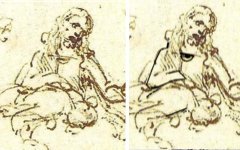Leonardo’s Landscape (1473)
Leonardo dated this landscape drawing as though it was a realistic rendering on a particular day in 1473 though scholars are divided. Some argue that, yes, the castle on the left existed while others believe that the scene is imaginative and point out specific spatial inconsistencies to support their view.1 From our point of view, though, the idea that any visual poet would draw such a realistic landscape is absurd. It cannot be so. Even later landscapes by artists actually described as Realists or Impressionists are not what they seem. Indeed scholars (some unaware of each other’s views) have shown how metamorphic figures appear in landscapes in every century since the Renaissance. Schongauer, Dürer, Altdorfer and Herri met de Bles drew such scenes in the fifteenth and sixteenth centuries, as did Corot, Courbet , Cézanne and Van Gogh in the nineteenth.2 Among modern artists in the twentieth century metamorphic landscapes are far more obvious because they made less attempt to hide them.

Leonardo, Landscape (1473) Pen and brown ink on white paper. Uffizi, Florence.
Click image to enlarge.
First, see if you can find a face in the drawing on your own. It is always good practice. Then, click on the next thumbnail to continue.
Here Leonardo has drawn the scene around the transparent fragment of a human face, as indicated in the diagram. Only the nose, beard and one eye are clearly marked. Although the lack of clarity will never convince skeptics, Leonardo’s careful positioning of key features are so meaningful that they are unlikely to be coincidental. For instance, a most unlikely waterfall pours over the “eye”, suggestive of tears, while huge trees (one green in diagram), inaccurately large, grow in “his mind”. Trees, among other ideas, symbolize the fertility of a creative soul. Although the face is not a self-portrait, it is not disimilar to other heads Leonardo drew and includes the horizontal creases of a frown. It is the mind of the artist-poet at the moment of the drawing’s creation, a specific moment which might explain Leonardo’s inscription. It is the date when the drawing was created.3
See conclusion below
Ernst Gombrich said of Albrecht Altdorfer, another early pioneer of landscapes: “Like many German painters he had another ambition: self-manifestation in the picture.” He went on to describe Altdorfer’s self-manifestation as a “deictic utterance … which calls attention to the circumstances of its own physical production…”, or, put more simply, an image which suggests its own creation. It is one of the basic principles that this website is trying to explain and we are not alone because another scholar later complained that modern professional art history, uncritically acquiescent to Establishment theories of the image, ignores the deictic reference, the reference to its own creation 4
More Works by Leonardo
Notes:
1. Antonio Natali, “The genesis of the ‘modern manner’. Leonardo: from Verrocchio’s workshop to his departure for Milan” in The Mind of Leonardo: The Universal Genius at Work (Florence: Giunti) 2006, p.
2. Felix Thürlemann “L’aquarelle de Dürer {fenedier klawsen}: La double mimesis dans l’analyse picturale d’un lieu géographique”, Revue de l’Art 137, Sept. 2002, pp. 9-18. Dürer’s St. Jerome Penitent in the Wilderness (B.61) also includes faces as double-images in the rock; J & M Tietz in H. Krohm and J. Nicolaisen, Martin Schongauer: Druckgraphik im Berliner Kupferstichkabinett (Berlin) 1991, p. 128, n.4, cited in Thürlemann, ibid., p. 18, n. 28
3. English poets, such as William Wordsworth and William Blake, sometimes describe London at a particular moment too though, like Leonardo, they intended no such geographical specificity in their poem’s interpretation except by those superficial readers who merely follow the story.
4. Christopher Wood, Albrecht Altdorfer and the Origins of Landscape, (London: Reaktion Books) 1993, p. 29; Wood also cites the subsequent comment by Norman Bryson.
Original Publication Date on EPPH: 20 Apr 2010. | Updated: 0. © Simon Abrahams. Articles on this site are the copyright of Simon Abrahams. To use copyrighted material in print or other media for purposes beyond 'fair use', you must obtain permission from the copyright owner. Websites may link to this page without permission (please do) but may not reproduce the material on their own site without crediting Simon Abrahams and EPPH.




